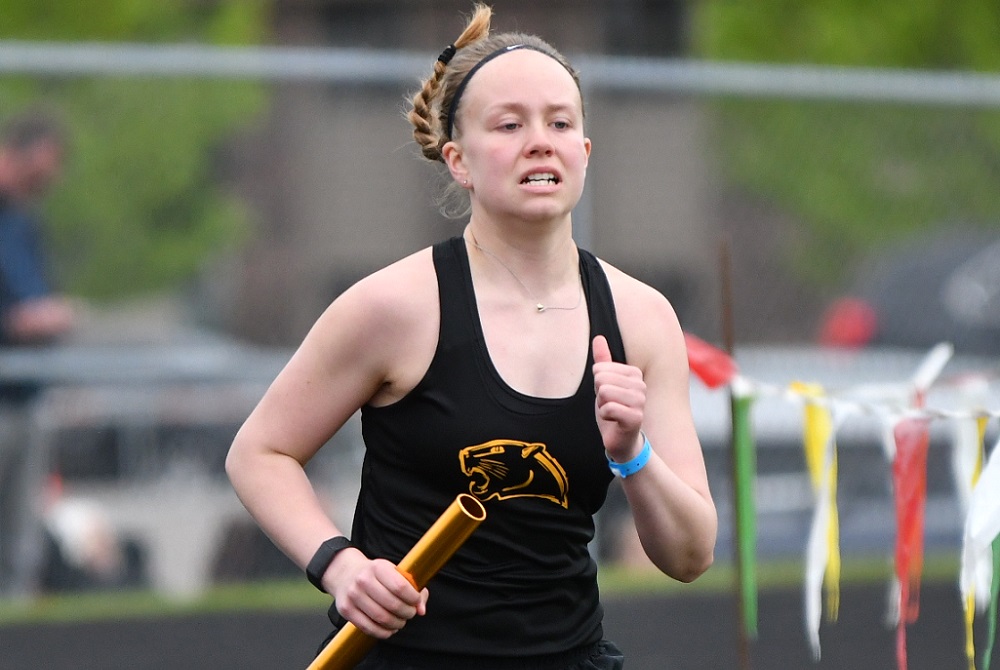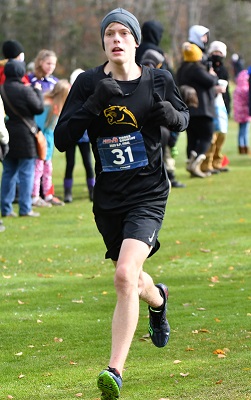
Ewen-Trout Creek Racers Fueled to Go Distance Again
By
John Vrancic
Special for MHSAA.com
May 25, 2021
BARAGA — Elise Besonen wasn’t always a huge fan of distance running.
 Then came 2020 and the COVID-19 pandemic, and the current Ewen-Trout Creek senior had a change of heart.
Then came 2020 and the COVID-19 pandemic, and the current Ewen-Trout Creek senior had a change of heart.
The University of Wisconsin-Superior basketball recruit now says she enjoys running.
Maybe there’s some truth to the saying “Absence makes the heart grow fonder.”
“I was pretty bummed when we didn’t get to run last year,” she said shortly after placing second in the 3,200-meter run at 13 minutes, 33.68 seconds in the Upper Peninsula Division 3 Regional meet last Wednesday at Baraga. “Then, I started running on some side roads with my dad, and it completely changed my mindset. It has been fun running for my dad. In my freshman year during driver’s ed, it was just us two. I guess it was sort of a blessing in disguise.”
Besonen was also runner-up in the 800 (2:40.21) and 1,600 (5:43.59) at the Regional, qualifying her for all three races at the Upper Peninsula Finals on June 5 at Kingsford.
“It was a pretty short meet,” said Besonen, who was also runner-up in the 800 at the previous Monday’s Copper Country Invitational in Houghton in a school-record 2:32.81. “The 800 and 3,200 were pretty close together, which made it pretty difficult because they were right on top of each other. At least my legs were warmed up.”
 Junior Jonah Nordine hadn’t run in nearly a week following a mishap during homecoming activities at the school two weeks ago.
Junior Jonah Nordine hadn’t run in nearly a week following a mishap during homecoming activities at the school two weeks ago.
“I fell off a bike and scraped up my knee and arm,” he said. “We usually have homecoming for basketball, but that got postponed due to COVID and (we) held it during baseball and track this year.”
Nordine, the reigning U.P. Division 3 cross country champion, won the 800, 1,600 and 3,200 in the Marcy Bracket Invitational at Bessemer on May 13, then was runner-up in the 800 (2:16.48) and 1,600 (4:40.27) and third in the 3,200 (11:28.33) at Baraga.
“I had a side ache in the 3,200,” he said. “I probably didn’t eat enough (that day). I was pretty happy with my times. I just wanted to qualify. We had perfect conditions at Bessemer. I didn’t run in Houghton, but it was quite warm. It was in the 80s. I’m just glad to be running this year after losing my freshman season to COVID.”
“Jonah’s success generates a lot of excitement for this team," added Ewen-Trout Creek track and cross country coach Brad Besonen, who also is Elise’s father. “Jonah’s personality changed after his success in cross country last fall. He has become more outgoing.”
Elise is best-known as a high-scoring guard who made the Division 4 all-state basketball team again this winter and was named Upper Peninsula Division 4 Player of the Year in the sport.
She figures to continue playing point guard for Wisconsin-Superior, another chase she’ll take on when her track season is done.
“There will be a lot of adjustments to make,” she said. “Everybody wants to be there, and I’m looking forward to that.”
 John Vrancic has covered high school sports in the Upper Peninsula since joining the Escanaba Daily Press staff in 1985. He is known most prominently across the peninsula for his extensive coverage of cross country and track & field that frequently appears in newspapers from the Wisconsin border to Lake Huron. He received the James Trethewey Award for Distinguished Service in 2015 from the Upper Peninsula Sportswriters and Sportscasters Association.
John Vrancic has covered high school sports in the Upper Peninsula since joining the Escanaba Daily Press staff in 1985. He is known most prominently across the peninsula for his extensive coverage of cross country and track & field that frequently appears in newspapers from the Wisconsin border to Lake Huron. He received the James Trethewey Award for Distinguished Service in 2015 from the Upper Peninsula Sportswriters and Sportscasters Association.
PHOTOS: (Top) Ewen-Trout Creek’s Elise Besonen completes her anchor leg of the 3,200 relay during the UP Division 3 Finals in 2019. (Middle) Jonah Nordine crosses the finish line first at last fall’s UPD3 Boys Cross Country Final. (Photos by Cara Kamps.)

Hastings Relays Reigns as State's Oldest Continuous Track & Field Meet
By
Steve Vedder
Special for MHSAA.com
April 10, 2024
Bob Branch remembers dabbling in other sports, but his first love was always running.
 The Hastings High School graduate admits he could never hit a baseball, football didn't especially appeal to him and basketball was just another way to spend time with friends. But for Branch, now 93, there was always track. That's the sport where his fondest and sharpest memories remain. And if you're talking track, many of his favorite memories come from participation in the state's oldest continuous track meet, the Hastings Relays.
The Hastings High School graduate admits he could never hit a baseball, football didn't especially appeal to him and basketball was just another way to spend time with friends. But for Branch, now 93, there was always track. That's the sport where his fondest and sharpest memories remain. And if you're talking track, many of his favorite memories come from participation in the state's oldest continuous track meet, the Hastings Relays.
Always held in early April, the meet dates back to 1937 – a bygone time that saw the first hostilities of World War II, gas at 20 cents a gallon and a loaf of bread selling for a dime.
And at a dusty old track surrounding the county fairgrounds in Hastings, a small relay event that included a scattering of participants from a dozen high schools was taking its first tentative steps.
Branch recalls a time when kids would run home after track practice because there were no buses, inexperienced young coaches had little actual knowledge of running fundamentals, and athletes looked at the sport as an afterthought after spending most of their high school days playing football and basketball.
 For Branch, the relays were the ideal way to ease into the track season.
For Branch, the relays were the ideal way to ease into the track season.
"I just liked to run," said Branch. "I remember I anchored a relay with my brother, and it always seemed cold when we had that meet. I remember teams would come from all over and you saw a lot of good athletes. Everybody seemed to have someone who was really good. Track wasn't very popular at that time, but I have a lot of good memories from running."
The Hastings Relays, which has changed formats and even names during its nearly nine-decade history, would traditionally kick off the track season. The meet was originally held at a makeshift quarter-mile track which surrounded the town's fairgrounds and was part of the city's annual Hastings Carnival – the track would become the midway during fair time.
The meet eventually moved to Johnson Field when the football field was dedicated in 1949 and ballooned to as many as 50 teams at its peak in 1957. For more than seven decades it was known as the Hastings Relays and then the Hastings Co-Ed relays before becoming the current Hastings Invitational, with the latest edition scheduled for Friday.
Johnson Field had a cinder track before it became an all-weather surface in the 1980s. During a time long before computers would be used to organize meet heats in mere minutes, Hastings coaches of all sports – defined as "volunteers" by the athletic department – would meet on the Friday before competition to hash out events.
People associated with the meet still recall the camaraderie built on those long Friday nights, followed by working what would often become 10-hour meets. Steve Hoke has been involved since watching his father, Jack, who coached teams at 15 of the meets beginning in 1951 and also had run in the first Hastings Relays. Steve Hoke later competed in the Relays as well during the early 1970s before becoming an assistant track coach, later the Hastings athletic director and now a volunteer worker.
"It was always a huge deal," said Hoke, who said the meet began as a pure relay event before transitioning to its current team format in the 1990s. "I remember we'd line the track the night before, and all the coaches would come to the house to organize everything. There was a brotherhood.”
 If you quiz many of the fleet of volunteers who've worked the relays over the years, each has a different memory from the meet. While Hoke describes the brotherhood and Branch the outstanding competition, others remember weather and the time a thunderstorm wiped out the line markings on the cinder track, or waking up to find three inches of snow that caused a rare cancellation of the meet. Others recall the shock of moving from the cinder to all-weather track or using the meet as an early measuring stick of what it would take to qualify for the state meet. The real old-timers remember the meet disappearing for three years during World War II.
If you quiz many of the fleet of volunteers who've worked the relays over the years, each has a different memory from the meet. While Hoke describes the brotherhood and Branch the outstanding competition, others remember weather and the time a thunderstorm wiped out the line markings on the cinder track, or waking up to find three inches of snow that caused a rare cancellation of the meet. Others recall the shock of moving from the cinder to all-weather track or using the meet as an early measuring stick of what it would take to qualify for the state meet. The real old-timers remember the meet disappearing for three years during World War II.
Hastings native and Western Michigan grad Tom Duits was the state’s second collegian to break the four-minute mile when he ran a 3:59.2 at a meet in Philadelphia in 1978. Duits, who ran in three Hastings Relays, was in line to join the U.S. Olympic team in 1980 before the United States pulled out of the games due to tension with Russia.
Duits has his own memories of the meet and the competition he faced there.
"I remember sunshine and being excited to be competing again. There were all these athletes swarming around; it was an awesome display of talent," he said. "It was always one of the best meets we'd be in. You could pretty much see the level of runners who would be at state, which made it a big deal. It was always early, but you could tell where you stood. It was great exposure."
Hastings track star Wayne Oom competed in four Hastings Relays from 1984-87. One of his sharpest memories was the difference between running on a raw cinder track versus the far more comfortable all-weather surface.
"Those cinders would grind into your skin," said Oom, part of the Hastings school record in the two-mile relay. "But I think it helped us because when we'd go to other tracks, it seemed we would run faster. I remember how competitive it was, especially in the distances. There were some great runners."
While participants have their unique memories, so do coaches. Former Saxons coach Paul Fulmer remembers 2008 when his team finished first on the boys side of the meet while his wife, Grand Haven coach Katie Kowalczyk-Fulmer, saw her girls team win the championship.
 "I knew we were one of the favorites to win because we were usually near the top of our conference and Regional," he said. "But then Katie's team was pretty good, and it was cool for them to win too."
"I knew we were one of the favorites to win because we were usually near the top of our conference and Regional," he said. "But then Katie's team was pretty good, and it was cool for them to win too."
Fulmer, who coached Hastings from 1978-81 and then 1985-2010, said at least part of the meet's popularity was derived from a unique way of scoring. Instead of individuals earning points solo, participants worked in pairs. For instance, two athletes would combine their shot put or long jump scores. New events such as the 1,500 relay and sprint medley were added.
"We had a tradition of being the state's oldest meet, and that was a big deal," Fulmer said. "And we ran a good relay; that attracted teams too. We took a lot of pride in that.
"And we'd get quite a lot of people to come to the meet. We'd set up until like 9 or 10 p.m., and then we'd have a party with all the coaches on Friday night."
While the meet has stretched 87 years, Branch said early participants and current runners have one thing in common: a drive to win. Branch ran in an era when the popularity of high school track was in its infancy. Today some of the best all-around athletes at a school are involved in the track program. The relays span the nearly nine decades in between.
"The quality of teams has gotten better and better," said Branch, the 1947 Lower Peninsula Class B Finals champ in the 220. "And this has made for a better meet. We would get guys who played football or baseball kind of drift into track, and that made the sport better. I think people began to appreciate track because we'd get teams from all over.
"We went from not really knowing what we were doing to track being a good sport. Even then, I'm not sure we appreciated what we had. We really liked the Hastings Relays and always wanted to do well there. It became popular and quite an honor to do well. Those are the kind of things I remember."
PHOTOS (Top) Racers run at the Hastings Relays, with several more awaiting their turns to compete at the longtime meet. (2) The author wrote on the 50th anniversary of the Relays for the Hastings Banner nearly 40 years ago. (3) Past athlete, coach and athletic director Steve Hoke shows some of the Relays awards from the 1930s. (4) Tom Duits was one of the state’s biggest track stars of the 1970s and ran in three Hastings Relays. (Top photo by Dan Goggins, Hoke photo provided by Steve Hoke and Duits photos provided by Tom Duits.)

